
At the beginning of September, I posted a blog about the ‘Wonder tree’ – a rowan tree (Sorbus aucuparia) on Dundreggan that I’d visited with some aphid surveyors in July, and which was supporting a whole host of invertebrate life. About 10 days later I spent a week at Dundreggan, when I was co-focalising a special ‘Up Close to Nature’ volunteer Conservation Week, so I took the opportunity during the day off in the programme to re-visit the tree, to see if the aphids were still there, and what else might be on the tree.

It was a beautiful day to walk up the Allt Ruadh, or Red Burn, as the bracken (Pteridium aquilinum) was just beginning to change colour from green to brilliant yellow, as a prelude to the fronds dying back for the winter. It’s the time of year when I really appreciate the bracken – in the summer it’s a real problem in much of the woodland at Dundreggan, as it grows taller than me, making it very hard to walk through, and it also harbours ticks (Ixodes ricinus).

When I was almost at the rowan tree, my eye was drawn to a bright red colour on the forest floor. It was a fly agaric (Amanita muscaria) mushroom – one of the many that have been fruiting in profusion this year. This particular specimen was not typical though, as it had been almost completely consumed by slugs. Most of the cap had been eaten, and there was a white track on the remaining section, where a slug had grazed as it travelled across the surface.

Just beside the fly agaric fungus, there was a green lush area, with lots of moss and ferns – I suspect it receives spray from the water in the burn, which encourages the profusion of pteridophytes (as the group of plants which includes ferns are known in scientific parlance). The bracken here was still green, and growing next to that were some hard ferns (Blechnum spicant), a species which remains evergreen during the winter.

When I reached the rowan tree itself, the first thing I noticed was that the berries, which had been green in July, were now ripe and bright red in colour.
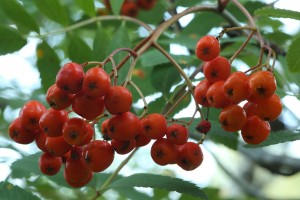
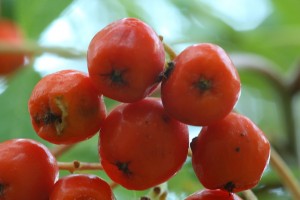
It’s a good year for berries on the rowans this year, and that will be appreciated by birds such as fieldfares (Turdus pilaris) and redwings (Turdus iliacus), which time their migrations from Scandinavia to the UK to coincide with the availability of the berries in the autumn. We’ll also take advantage of the abundance of rowan fruit, collecting the berries to propagate young rowans from the seeds they contain.

When I’d been out in July with the aphid surveyors, we’d seen some aphids feeding on the fruit stems on the tree, but there was no sign of them this day. According to the report that Bob Dransfield and Bob Brightwell (the surveyors) have prepared, those aphids feeding on the fruit stems produced only alates – winged adult aphids – when they were reared, whereas the aphids feeding in the leaf galls they’d induced all produced apterae – wingless adults – when they were reared to maturity.

The leaf galls – clusters of leaves that were bent down and together by the feeding of the aphids – had all turned brown by this time, and were very obvious as soon as I approached the tree.


There were still plenty of aphids feeding on the rowan stems there, and lots of wood ants (Formica lugubris) were again attending them. The ants harvest the honeydew that the aphids produce as a waste product – it’s one of their main food sources – and in return they apparently provide some protection to the aphids from predators and parasitoids, which otherwise can take a heavy toll on aphid colonies.

Certainly, ‘the Bobs’, as the surveyors call themselves, didn’t see much evidence of predators or parasitoids in these aphids on the rowan, so it appears that the ants were definitely having a positive effect on the aphids. In July there had also been a lot of other insects flying in to harvest the honeydew that had dripped from the aphids on to the rowan’s leaves, but I didn’t see much of this now in September. Perhaps that was because most insects had completed their active cycle for the year, and had gone into their dormant phase, either as adults or larvae, in preparation for overwintering.
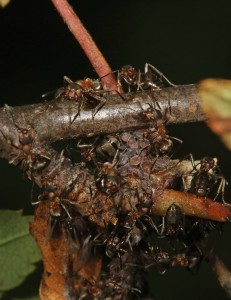
I watched the aphids and the ants for a while, and the numbers of ants fluctuated, sometimes with only a few of them tending the aphids, while at other times there were lots of them.

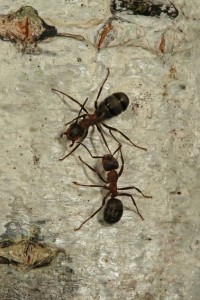
This was due to the considerable traffic of the ants up and down the tree – presumably the ants came up to take their turn at feeding from the aphids, and then descended once they’d had their fill.


The first time I’d been at this rowan tree, back in July, there had been an orb web spider (Araneus diadematus) sitting in its web just beside the trunk, and one of the wood ants had got caught in the web. There was no sign of the spider on this day in September – it had probably long since moved to another hunting site – but I did see a different species of spider on the rowan’s trunk. It wasn’t one I could recognise myself, and I’m still waiting to hear from a spider expert if he can make a positive identification from my photograph.
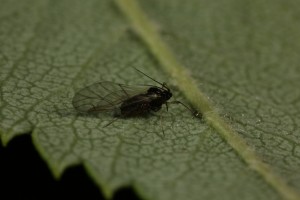
Turning my attention back to the rowan’s leaves, I noticed a small dark shape on the underside of one of them. Looking at it through my hand lens, I noticed it was an adult winged aphid, and I assumed it must be an adult of the species (Dysaphis sorbi) that was feeding in the leaf galls. I took some photographs and sent them to Ed Baker, who had done the initial aphid survey at Dundreggan for us in 2012, who confirmed this identification.
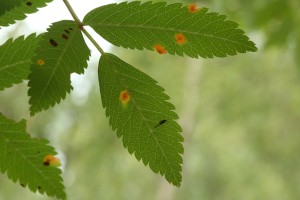
As I looked at this aphid, I also noticed some orange spots on the rowan’s leaves. I had an immediate intuition as to what they were, and this was confirmed when I looked at them closely through my hand lens. They are galls that are induced on the surface of rowan leaves by a rust fungus (Gymnosporangium cornutum). I had seen these before in previous years, on other rowans at Dundreggan, and the fungus that causes the galls has a very interesting and unusual life cycle.
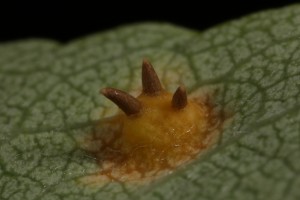
It alternates between two different hosts during the year, with fruit bodies consisting of orange gelatinous blobs appearing on the stems of juniper bushes (Juniperus communis) in the spring. These are relatively inconspicuous, and much less obvious than the spectacular ‘tongues of fire’ produced by a closely related fungus (Gymnosporangium clavariiforme) on juniper. While that species goes on to infect hawthorn (Crataegus monogyna) in the other part of its life cycle, Gymnosporangium cornutum goes on to infect rowan.
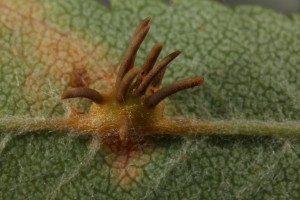
There, it fruits in the summer, initially forming the orange blisters I saw on the leaves where the adult winged aphid was. Over time, pointed protuberances emerge from the blisters, and these are small at first, as shown in the photo above, but then become more elongated, as can be seen in the photo here to the right. These eventually release fungal spores, which then go on to re-infect juniper, where the species fruits again the following spring, and so the cycle of the rust fungus continues alternating between its two hosts.
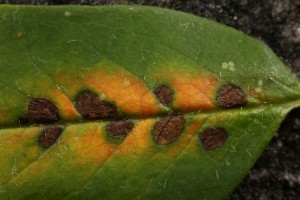
How did this species evolve to utilise these two very different host trees? As far as I’m aware, no one knows the answer to that, but it does illustrate the remarkable complexity of life in the forest, and the inter-connectedness that exists between many different organisms. On another leaf on the rowan tree I noticed a different pattern of orange areas, with brown dead sections of the leaf in between them. These brown areas were, I suspected, leaf mines of some sort.

Turning the leaf over, I saw the same pattern of damaged tissue on the underside, and this may be a clue to the identity of the organism that caused these blotches. There’s a large variety of invertebrates, mainly micro-moths, but also including flies, beetles and sawflies, that make mines in leaves. It’s a subject I have an increasing interest in, and there’s an excellent web site about leaf mines in the UK, entitled British Leaf Miners.

As often seems to happen, I had got my eye in for interesting things on the leaves of this rowan, and shortly afterwards I spotted one leaf that was partially curled in from one side to the other. I could see there was feeding damage on the leaf, and also some silk which had been used by the causative agent to pull the two sides of the leaf together. I looked at the leaf carefully for a few minutes, taking some photographs as I did so, while I pondered whether to open the leaf curl up or not.
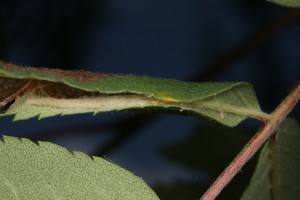
As I looked more closely, it appeared to me that the leaf was empty – the original occupant had gone. This gave me the confidence to open up the leaf, as I felt I wouldn’t be disturbing or disrupting the life of the invertebrate that had caused the leaf to curl. On close inspection though, I noticed a minute little baby spider on the leaf, near its base, and I managed to get a photograph of that using my high power macro leans at its maximum magnification.

The little spider was almost translucent, and was, I suspect, very young, probably having only hatched from an egg a few days previously. I knew from my conversations with the arachnologists who’ve carried out surveys for spiders at Dundreggan that it is impossible to identify spiders like this when they are so young, because the features required to determine which species they are haven’t developed enough at this early stage. So, it was a case of just enjoying this tiny spider in the moment, without ever knowing what its scientific name is.

I took the leaf off the tree carefully and put it down on the ground on a rock, where I opened it up. This clearly revealed the area where the now-departed occupant had been feeding – a brown section of damaged leaf tissue, inside the area which had been sewn together with the silk. Tellingly, there was also a pile of small black spherical shapes, which are the frass, or waste products, produced by the caterpillars of moths and butterflies. I subsequently sent both the photos and the leaf itself to a couple of moth specialists, and they were able to confirm that the leaf roll had been made by a micro-moth (Parornix scoticella).

I was delighted to see that next to the frass inside the rolled leaf, there were some aphids feeding. These were clearly a different species to those which were feeding on the stems and inducing the leaf galls there, as they were a different colour and feeding on a different part of the rowan tree. Ed Baker confirmed that they are a species called the apple-grass aphid (Rhopalosiphum oxycanthae). This is a polyphagous species, meaning that it feeds on a range of plants, including apples and other species such as rowan in one part of its annual cycle, and is also host alternating, because it feeds on grasses in another part of its yearly rhythm.
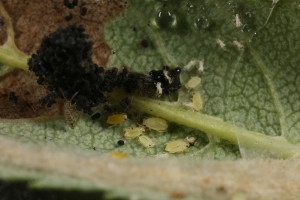
While I was looking at the aphids, my attention drawn by another small invertebrate that approached the frass. I didn’t know what it was, but when Ed saw my photographs he replied that it was a springtail and most likely a species called Entomobrya nivalis. Springtails are not insects, although they may look like them to the casual observer. They are in fact an entirely different group of invertebrates, and we had a man called Peter Shaw carry out a survey for them at Dundreggan earlier this year.

I sent the photograph to Peter and he was able to immediately confirm Ed’s provisional identification – Entomobrya nivalis is apparently quite a common species of springtail, and Peter had recorded it at Dundreggan during his survey in April. It may well have been feeding on the frass left behind by the caterpillar of the micro-moth (Parornix scoticella), and was the fourth different organism I had found evidence of in this one rowan leaf. The others were the aphids, the tiny baby spider, and of course the micro-moth itself. It’s truly remarkable to me that such a small leaf could be host to so many different organisms, and it summarised my conclusion for the day – that I had been right to name this rowan the ‘wonder tree’! Returning to it this day in September, I hadn’t been sure if it would live up to the reputation it had gained after my previous visit in July, but in fact it surpassed it. That evening I told all the participants on the ‘Up Close to Nature’ Week about my experience with the tree, so on the final day of our programme I took everyone there, so that they could all see the life on the tree for themselves – I think they were suitably impressed!
Hi Alan
Thanks for showing our group the Wonder Tree in September, really enjoyed reading this blog and all the wonderful discoveries you have made on this one tree.
Looking forward to it, A!
I love love love that you’re such a detail person, Alan. So nice to know that someone slows down and pays attention to these lovely small things. Thanks for introducing me to those small (but incredibly important) small things on the Burren. And to those at Dundreggan.
Hi Janet,
Many thanks for your comment, and I’m glad you’re continuing to enjoy my blogs. I hope one day I’ll get a chance to show you the wonderful small things of Dundreggan in person!
With best wishes,
Alan
Thanks for the wonderful adventure in biological diversity! A good lesson in observation.
Hi Jeanie, Thanks for your comment, and I’m glad you appreciated this blog – there is indeed a wonderful world of biological diversity out there!
With best wishes,
Alan